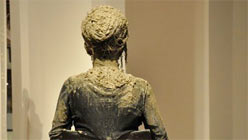The work of Palestinian performance and video artist Wafaa Yasin utilizes stark symbolism and corporal discomfort to assert Yasin’s own belief in the interrelatedness of art and politics. For example, in her January performance Allah, Alwatan, Almalik (2011), at the Performance Art Institute in San Francisco, a male assistant mixed concrete and poured it over the seated artist’s long thick hair. Jordanian television clips about Black September — a monthlong period of violence against Palestinians initiated by King Hussein in 1970 — played in the background. Once her hair was fully coated in concrete, Yasin stood and began to walk slowly in circles, weighed down by her heavy head. As she processed, she chanted “Allah, Alwatan, Almalik” and dropped small round stones on the ground.1 The falling marbles represented each Palestinian killed in Black September, while the crumbly concrete caked in Yasin’s hair stood in for the rubble that trapped Palestinian pilots shot down by Israelis. The sound of the marbles hitting the hard floor resounded throughout the gallery, and the artist’s repetitive mantra lent a morose gravity to the performance.
The overt symbolism in her performance is indebted to Joseph Beuys’ style of mythic performance art, in which, for example, a coyote represented the pre-colonial United States (in the famous I Like America and America Likes Me [1974]); and honey, gold leaf, and a dead rabbit served as symbols in a critique of over-intellectualization (How to Explain Pictures to a Dead Hare [1965]). Beuys’ performances were often analogous to rituals, and the artist believed performance could evoke a spiritual response from his audience that might reach outside the confines of the gallery. Like Beuys’ mythic disquieting performances, Yasin’s work suggests a similar belief in art’s potential for social and political transformation.
Yasin’s performances reflect her desire to educate, and possibly even change, her audience, and in doing so they draw from her position as a perpetual outsider to express universal displacement. Yasin grew up a Palestinian minority in Galilee and attended the prestigious Bezalel Academy in Jerusalem, where she was one of two Arab students out of a class of forty-five. In the years following her graduation, she participated in residencies around Europe, before moving to San Francisco to pursue her MFA in Social Practice from California College of the Arts in 2008. Her performances suggest both a personal struggle with her constant status as a foreigner and a broader desire to expose others to political struggles in the Middle East.
In the public performance Aesh (Livelihood) (2008), which was staged during a residency in Marseilles, Yasin used her body as a means of political and poetic expression. The artist crawled along the sidewalk in a busy section of the city for forty-five minutes, pushing a piece of Moroccan bread across the ground with her face, her hands positioned as though tied behind her. She crossed a street, as onlookers gaped and occasionally offered to help, before she ultimately came to a stop at the edge of the ocean. The performance is an interpretation of two Al-Jazeera interviews: an Iraqi prisoner describing his time in jail during the 1990s, and a description of the journey by boat taken by Moroccan and Algerian immigrants to France. Her physical position evoked the prisoner, while her literal movement suggested the immigrants’ journey. The performance employed a visceral direct use of the artist’s body to make a political statement that disrupted the daily life of ordinary citizens of Marseilles.
Aesh is indebted to British-born Palestinian artist Mona Hatoum’s early performance work, which also sought to draw attention to the position of immigrants in Europe, as well as to Francis Alÿs’ endurance exercises. For example, in the performance Them and Us… And Other Divisions (1984), a black-hooded Hatoum crawled through a London square full of affluent Englishmen. In The Green Line (2005), Alÿs walked fifteen miles through divided Jerusalem carrying a perforated can of green paint, allowing the paint to drip in a continuous line onto the ground. The route he chose is the 1949 armistice border that Moshe Dayan drew on a map in green crayon after the Israeli-Arab war. In the video performance Paradox of Praxis 1 (Sometimes Doing Something Leads to Nothing) (1997), he pushed a large block of ice through the streets of Mexico City for nine hours until it had completely melted. Both Hatoum and Alÿs demonstrate the potential for a straight- forward physical performance to act as an understated act of protest, and Yasin similarly uses her body as a metaphor for political injustices.



